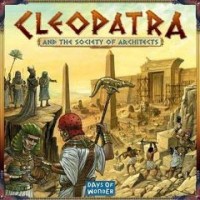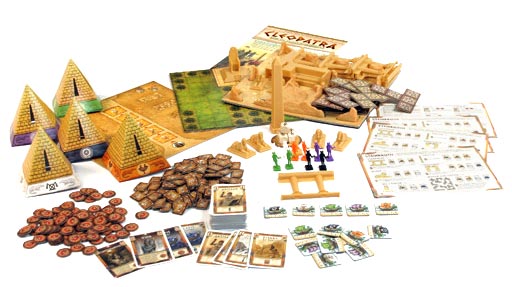
Cleopatra and the Society of Architects
The sands of Egypt, 50 BC. The pyramids are crumbling, the temples are in ruins,and even the nose of the Great Sphinx looks like it might fall off any day now. Cleopatra is one unhappy queen!
Now she has called on the members of the Society of Architects to build a magnificent palace in Alexandria. Work has started in earnest, and the competition promises to be intense. On any given day, you might be found scouring the markets in search of Resources worthy of a Queen or tirelessly working your crew in the Quarry. Some of your brethren have been making rather inexplicable progress, coming up with goods faster than humanly possible, and erecting new pieces of the Palace at breakneck speed. Rumors of midnight meetings and secret, forbidden rituals have been spreading. Now, amulets and hieroglyphs honoring Sobek, the Crocodile-god, are appearing in the strangest places. Corrupt officials and building materials of dubious origin may help you stay ahead, but beware: the price of corruption is sure to be high!
Will temptation drive you to the worshipers of Sobek, and to a violent end in the belly of Cleopatra's favorite pet? Or will you survive to become the chief architect of the Kingdom - and win the great riches offered by the Queen?

User Reviews (2)
Add a Review for "Cleopatra and the Society of Architects"
You must be logged in to add a review.

That’s right; I said “tactile”; no mistake. Cleopatra and the Society of Architects is a fun, component-rich game has a lot of replayability. In this excellent game by Days of Wonder, the players take on the role of ancient Egyptian architects designing the ideal tomb for Cleopatra.
The components for this game are excellent molded plastic pieces that you build throughout the game. The box itself is a part of the “board”, and you will be erecting columns and doors alongside it, mosaics and a throne and on top of it, as well as sphinxes and obelisks before it. It is great for those who like interesting components.
There are cards that represent actions and building materials. Each piece needs a specific number of material cards. There are role cards that allow you to use a character to do an action. Most importantly, though, some of the cards are tainted. You earn corruption tokens by playing tainted cards throughout the game, deposited into your own little pyramid to keep the number secret to those not paying attention.
The game ends when the Cleopatra token gets to the doors and surveys the palace. At this point, corruption matkers are counted and the one with the most gets sacrificed to Sebek, the crocodile god. After that, victory points are counted among the players stil remaining and the highest total wins. It is a fun and thematic game, and the components really enhance the experience!
I acquired this game in a group-purchase almost a year ago, and we finally got it to the table last night. Chipboard bits, cards, plastic figures, cardboard pyramids, plastic temple parts, chipboard pentominoes, dice, counters – a bit overwhelming. The packaging is less than great – two layers, with a tray that’s OK, but the other piece that holds the plastic temple parts – not so great, and hard to repackage. Plan on a very large playing space! You need to use the BOX BOTTOM as part of the game, too. (Those plastic template parts made it feel more like a toy than a game.)
The rules booklet had a good inventory of parts, but was a little unclear about set-up. Otherwise, all was well described and easy to find for later reference. As with most games of this complexity, a few rounds and we were running along fairly well. The thing with the ankh dice and the offerings was a little odd. Fit the theme, but didn’t flow so well with the rest of the play. The resource management, construction, characters, and corruption all worked very well. The pentominoes to build the courtyard area also seemed a bit contrived, a separate game idea that was not too well integrated with the rest.
In the end – we had fun with it, and might bring it out again someday, but I don’t see it being high on anyone’s wish list. If the components were less “toy-like” it might help. All those plastic bits seemed to cheapen it for us. It looks more like a mass-market game, but far too much game for a mass market audience. Conclusion: I’d give it another try, but I’d rather play 7 Wonders.